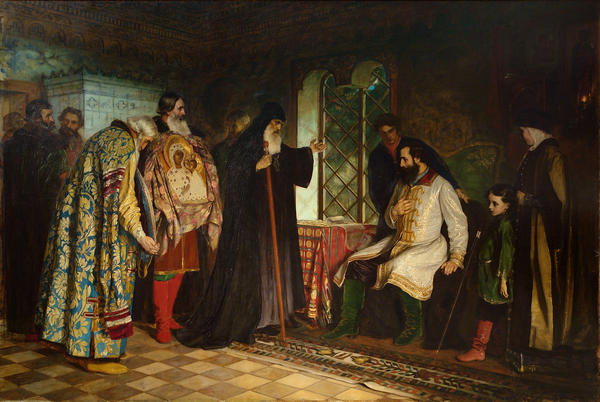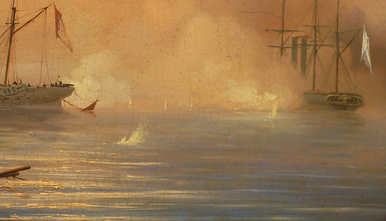Vasily Savinsky was a Russian painter, graphic artist, professor and full member of the Imperial Academy of Arts. In 1875-1882, he studied at the St. Petersburg Academy of Arts. Since 1888, he worked as an instructor at the Stieglitz Art School. From 1911 to 1930, he worked and taught art in his personal workshop at the Academy of Arts.
His work Prince Dmitry Pozharsky and Envoys from Nizhniy Novgorod (1882) belongs to the genre of history painting. The genre emerged in the times of Renaissance and referred to scenes from history as well as mythological and biblical subjects. History paintings depicted events of the past important for a nation or for the entire humanity. Artists would often deliberately glorify a certain event from the past thus creating a historical myth.
Vasily Savinsky painted The Envoys from Nizhniy Novgorod as a graduation work for the Imperial Academy of Arts. The artist depicts a scene when the envoys from Nizhny Novgorod, ask Prince Dmitry Pozharsky to lead the Second People’s Militia. Among the envoys, the viewer can see Theodosius, a priest from the Pechersky Ascension Monastery.
At that time, Prince Dmitry Pozharsky stayed in his estate in the village of Yurino, Nizhny Novgorod County, where he was healing his wounds after fighting in the ranks of the First Militia against the Polish troops. Although he had not recovered yet, he agreed to do it. He said: “Tell those who sent you that I am happy to suffer and die for the Orthodox faith.”
Trained in academic traditions, Vasily Savinsky followed the traditional concept of composition: the brightly lit window symmetrically divides the figures in two groups – the envoys and Dmitry Pozharsky with his family. The dark figure of the priest with his arm extended forward is the visual and semantic focal point of the composition that connects the two groups. The brightly colored vestments emphasize the solemnity of the moment. In 1882, the work was awarded a Big Gold Medal of the Imperial Academy of Arts; the artist got the title of the class painter of the first order and the right to travel abroad to perfect his skills.
In Soviet times, Vasily Savinsky worked as a senior instructor at the Higher Art and Technical Workshops. He spent most of his time with his students teaching them to observe nature and objects, to pay attention to detail, to study plaster replicas of ancient sculptures and practice drawing. Among his students were Isaac Brodsky, Valentin Serov, Arkady Rylov, Nikolai Sheverdyaev, and many others.
His work Prince Dmitry Pozharsky and Envoys from Nizhniy Novgorod (1882) belongs to the genre of history painting. The genre emerged in the times of Renaissance and referred to scenes from history as well as mythological and biblical subjects. History paintings depicted events of the past important for a nation or for the entire humanity. Artists would often deliberately glorify a certain event from the past thus creating a historical myth.
Vasily Savinsky painted The Envoys from Nizhniy Novgorod as a graduation work for the Imperial Academy of Arts. The artist depicts a scene when the envoys from Nizhny Novgorod, ask Prince Dmitry Pozharsky to lead the Second People’s Militia. Among the envoys, the viewer can see Theodosius, a priest from the Pechersky Ascension Monastery.
At that time, Prince Dmitry Pozharsky stayed in his estate in the village of Yurino, Nizhny Novgorod County, where he was healing his wounds after fighting in the ranks of the First Militia against the Polish troops. Although he had not recovered yet, he agreed to do it. He said: “Tell those who sent you that I am happy to suffer and die for the Orthodox faith.”
Trained in academic traditions, Vasily Savinsky followed the traditional concept of composition: the brightly lit window symmetrically divides the figures in two groups – the envoys and Dmitry Pozharsky with his family. The dark figure of the priest with his arm extended forward is the visual and semantic focal point of the composition that connects the two groups. The brightly colored vestments emphasize the solemnity of the moment. In 1882, the work was awarded a Big Gold Medal of the Imperial Academy of Arts; the artist got the title of the class painter of the first order and the right to travel abroad to perfect his skills.
In Soviet times, Vasily Savinsky worked as a senior instructor at the Higher Art and Technical Workshops. He spent most of his time with his students teaching them to observe nature and objects, to pay attention to detail, to study plaster replicas of ancient sculptures and practice drawing. Among his students were Isaac Brodsky, Valentin Serov, Arkady Rylov, Nikolai Sheverdyaev, and many others.



